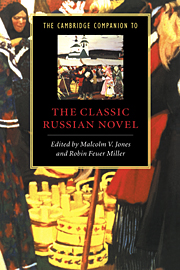6 - Religion
from Part 2 - The culture
Published online by Cambridge University Press: 28 May 2006
Summary
Speaking of the “Russian novel,” we often refer to the classical canon of highly individual works by the great nineteenth-century Russian authors. It is, however, also possible to define the “Russian novel” somewhat differently, as an open adaptive system in which the individual works are parts of a continuous development. In this system, characters and events are represented according to a set of patterns, or schemata, that are subject to constant variation when applied to the social world around us and to the processes that take place in people's minds. These are the two basic aspects of narrative - the “landscape of action” and the “landscape of consciousness” - the two landscapes that according to Jerome Bruner characterize this mode of thought as opposed to the logico-scientific, or “paradigmatic” mode.
The outer landscape of action unfolds according to an action pattern, or plot. But in this landscape of action changes occur because of changes taking place in the inner landscapes of the characters involved. To understand a narrative is therefore to have an understanding of the changes both in the characters' inner landscape of thought and in the outer landscape of events. The two are aspects of the same, since, as Michael Carrithers puts it, “the metamorphosis of thought entails the metamorphosis of social relations and vice versa.” In the following, our attention will be centered on the function of art and religion in the “dual landscape” of the Russian novel, understood as an open adaptive system.
- Type
- Chapter
- Information
- The Cambridge Companion to the Classic Russian Novel , pp. 104 - 129Publisher: Cambridge University PressPrint publication year: 1998
- 1
- Cited by



